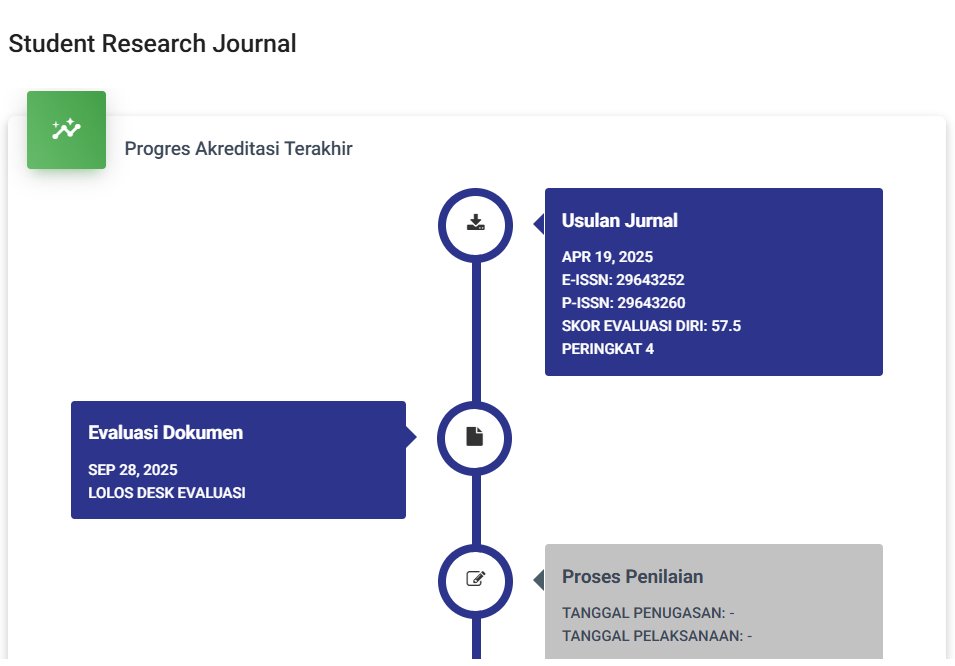The Use Of Discourse Markers To Improve Students’ Listening Skills In English Teaching Learning For Seventh Grade SMP Negeri 1 Mojotengah Wonosobo In 2023/2024 Academic Year
DOI:
https://doi.org/10.55606/srjyappi.v2i4.1373Keywords:
Listening Skill, Discourse Markers, English TeachingAbstract
The skill of listening to the meaning and function behind speech is sometimes difficult for some people. This thesis analyzes discourse markers in the teaching and learning process using a discourse marker approach. The aim of this research is to determine the implementation of the listening learning model in improving student learning outcomes in each cycle, and to determine student learning motivation in class VII SMP Negeri 1 Mojotengah. The research method uses Classroom Action Research (PTK). The research is carried out in two cycles, each cycle consisting of planning, implementing actions, observing and reflecting. The subjects of this research are 32 students in class VII A of SMP Negeri 1 Mojotengah. The data collection uses in this research is quantative data. Quantative data takes the form of observation sheets, interviews, tests and documentation. The results obtained from this research include: 1) the application of the discourse model can improve students' listening skills, 2) student learning outcomes in each cycle have increased above the KKM, namely 75, after the discourse marker learning model was implemented. The average student learning outcome in the pre-cycle was 64 with a percentage of 53% (low), then cycle I obtained an average score of 71.88 with a presentation of 59% (medium), but it was still below standard so it continued in cycle II and experienced an increase with an average value of 88.75 with a percentage of 88% (high). This shows an increase from pre-cycle, cycle I, and cycle II.
References
Ali, IY, & Irawan, WD (2023). Analysis of Cohesion in the Collection of Poems Dreaming of Rain in the Black Hotel by Djuhardi Basri as an Alternative Teaching Material in High Schools. Griya Cendikia, 8 (1), 10-21.
Asih, KM (2020). Cohesion and Coherence in Java Post Newspaper Discourse Zetizen Rubric. Thesis Not Published. Surabaya: Indonesian Language and Literature Education Study Program, Surabaya State University FBS.
Aziz, A. (2021). Grammatical Cohesion (Tatama Nahwi) Application of Substitution and Ellipsis in Al-Quran Verse Discourse. Mumtaz: Journal of Al-Quran and Islamic Studie, 5 (02), 157-168.
Aziza, DA (2023). Textuality Analysis in Ustadz Adi Hidayat's Religious Lectures as an Alternative to LKPD in Learning Indonesian at High School (Doctoral Dissertation, Fkip Unpas).
Fahruroji, F. (2021). Understanding Democratic Discourse in the Textbook Model.
Hanif, A., Rahman, S., Masmuddin, M., Windiyani, W., & Alifah, A. (2023). Discourse Morality and the Authority of Religious Discourse on Social Media. Palita: Journal Of Social Religion Research, 8 (1), 79-96.
Hasriadi, H. (2022). Metode Pembelajaran Inovatif di Era Digitalisasi. Jurnal Sinestesia, 12(1), 136-151.
Kasanah, U., Rahmayantis, MD, & Pitoyo, A. (2023). Grammatical Aspects in the Novel Rasa by Tere Liye (Discourse Studies). Discourse: Journal of Language, Arts, And Teaching, 7 (2), 152-162.
Lestari, HP (2021). Critical Discourse Analysis of the Lyrics of the Song " Lexicon " by Isyana Sarasvati. Undas: Journal of Language and Literature Research Results, 17 (1), 47-62.
Mariam, V.S. (2020). Analysis of Discourse Readability Using Fry Charts in 2013 Curriculum Thematic Books for Class VI Semester 2 2018 Revision (Doctoral Dissertation, Fkip Unpas).
Marina, P. (2024). Analysis of Official Letter Writing at the Nanga Lot Village Office, Seberuang District, Kapuas Hulu Regency (Doctoral Dissertation, Ikip Pgri Pontianak).
Nantara, D. (2022). Formation of Student Character Through School Activities and the Role of Teachers. Tambusai Education Journal, 6(1), 2251-2260.
Pramadani, U.A. (2023). Economic Discourse in the Times Indonesia News Portal 2022-2023 Perspective of Teun A. van Dijk (Doctoral Dissertation, Stkip Pgri Pacitan).
Rohmah, KR, & Wulandari, RS (2023). Cohesion and Coherence in the Short Story Sungai by Nugroho Notosusanto. Lexis: Journal of Indonesian Language and Literature Education, 3 (1).
Sahid, S. (2019). The Analysis of Parts of Speech Shift on the Indonesian Translation of Paulo Coelho’s The Alchemist. Metaphor, 1(1), 25-36.
Shahbana, E. B., & Satria, R. (2020). Implementasi Teori Belajar Behavioristik Dalam Pembelajaran. Jurnal Serunai Administrasi Pendidikan, 9(1), 24-33.
Somadayo, S., & Purnomo, E. (2021). Ability to Understand Paragraph Cohesion and Coherence in the Narrative Essays of Ternate Health Polytechnic Midwifery Semester I Students. Pedagogy, 9 (2).
Syahputra, E., Tanjung, NF, Fatimah, D., Husna, A., & Aulia, W. (2022). Analysis of Errors in Using Indonesian in Selling Advertising Products in Indonesia. Multidisciplinary Journal Dehasen (Mude), 1 (3), 285-288.
Tambunsaribu, G., & Galingging, Y. (2021). Masalah yang dihadapi pelajar bahasa Inggris dalam memahami pelajaran bahasa Inggris. Jurnal Dialetika, 8(1), 30-41.
Tara, F., & Arjun, M. (2020). Types of Sentence Coherence in the Crime Rubric Story Newspaper Tribune Jambi Edition March 2019. Aksara: Scientific Journal of Indonesian Language and Literature Education, 3 (2), 185-195.
Wati, II, Mulyati, SM, & Khotimah, KK (2020). Cohesion and coherence in the novel Kkn di Desa Penari by Simpleman and its implications for Indonesian language learning in high school. Jubindo: Journal of Indonesian Language and Literature Education, 5 (3), 139-147.
Wulandari, SA, & Sabardila, A. (2023). Grammatical and Lexical Cohesion of News Discourse on Singer Putri Ariani in Online Media. Basataka Journal (Jbt), 6 (2), 429-441dilalui (Rusman, 2011).
Downloads
Published
How to Cite
Issue
Section
License
Copyright (c) 2024 Yekti Nur Rahmawati, Sahid Sahid

This work is licensed under a Creative Commons Attribution-ShareAlike 4.0 International License.








